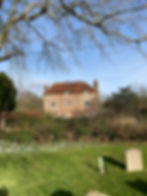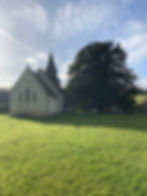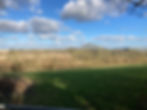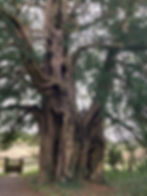The Manor Farm
- nicholasjdenton
- Mar 4, 2022
- 9 min read
Updated: Oct 29, 2022

The rock-like mud unfroze a little and rills
Ran and sparkled down each side of the road
Under the catkins wagging in the hedge.
But earth would have her sleep out, spite of the sun;
Nor did I value that thin gilding beam
More than a pretty February thing
Till I came down to the old Manor Farm,
And church and yew-tree opposite, in age
Its equals and in size. The church and yew
And farmhouse slept in a Sunday silentness.
The air raised not a straw. The steep farm roof,
With tiles duskily glowing, entertained
The midday sun: and up and down the roof
White pigeons nestled. There was no sound but one.
Three cart-horses were looking over a gate
Drowsily through their forelocks, swishing their tails
Against a fly, a solitary fly.
The Winter's cheek flushed as if he had drained
Spring, Summer, and Autumn at a draught
And smiled quietly. But 'twas not Winter -
Rather a season of bliss unchangeable
Awakened from farm and church where it had lain
Safe under tile and thatch for ages since
This England, Old already, was called Merry.
The Manor Farm was one of Edward Thomas's earliest poems, written on Christmas Eve 1914. It described a visit to the remote Manor Farm and church at the hamlet of Priors Dean one Sunday in early 1910. Edward Thomas was clear about the location of the farm in a letter to WH Hudson in response to his critique of the poem, defending his use of the word Merry in the last line. "I feel here as if the Merry England asleep at Prior's Dean added to the sleepiness and enriched it somehow." (23rd March 1915)
From his field note books it is evident that he made several visits to Priors Dean in the early part of 1910, and he later drew on these notes for the poem. Priors Dean was a couple of miles from the new house at Wyck Green on top of the Ashford Hangers where the Thomas family had moved the previous autumn. It would have been a shorter walk than when they had lived at Berryfield Cottage and would have been a good place to explore further on solitary or family expeditions.

The first expedition seems to have been on February 23rd where he described two of the key images of the poem - the doves or white pigeons on the sunny roof and the cart horses drowsily swishing their tails:
"I sh(oul)d like to be white pigeons on the long steep roof of brown old tiles in the sun when there is no wind & the farm yard is hushed & the horses swish their tails & the manes hang over eyes."
So the timeless view of Merry England and the season of bliss unchangeable that concludes the poem had been prompted initially by the poet imagining becoming a dove on the farm roof, enjoying the midday sun.

The next entry about Priors Dean was either on 17th March 1910 or 20th March (possibly the Sunday of the poem):
"Priors Dean Manor
in sun w(ith) pigeons on steep tiles - it was not so when I kept pigeons"
Again the pigeons or doves take centre stage. Pigeon-keeping was a favourite hobby during his childhood in South West London between the commons. In his autobiography "The Childhood of Edward Thomas" he described his and his friends' pigeon-keeping exploits with enthusiasm.
He used to keep up to a dozen of different breeds - ''athletic homers, heavy wattled antique-looking dragons, dainty almond tumblers, feminine owls...a pair of red-ruffed Jacobins sent from Wales". None flew much beyond the topmost chimney pots and many got lost or caught by cats. This didn't deter him from spending much of his pocket money on purchasing new ones and building cages to house them.
His friends and neighbours also kept pigeons in their lofts and back gardens, many with more success than he had. He described the sublime feeling as he watched the high circlings of pigeons visible from the family's back garden and their rushing low flight between chimneys as they returned home.
The white pigeons of Priors Dean clearly had a blessed life compared to the caged pigeons of London.

He made another visit to Priors Dean later in April:
"Lovely sunny blue breezy white cloudy day - SW wind - chiffchaff everywhere - a warm hop coomb w(ith) several robins & many primroses - hot dry farm w(ith) horses leaning on gate sniffing at Bronwen's haylike hair. Pigeons flapping & billing - pigs barking - guinea hens rush out & pursue us w(ith) grating cries - deserted church yard at Prior's Dean & blackbird scolding us - chaffinch here & there. Pewit goes over high up - we expect cuckoo."
Whether the farm was the Manor Farm or one en route from Wyck Green is not clear. It would seem more likely that it was the Manor Farm because of the trajectory of the walk he noted down that day. The main evidence for this lies in the reference to the "hop coomb".
Hop fields were common in those days on the terrace at the bottom of the high chalk hangers stretching from Alton to Petersfield (known as the Upper Greensand terrace). There were numerous oast houses and hop kilns and, according to the Hampshire County Integrated Assessment, "Nowhere else in Hampshire is there such a high concentration. This area represents the western extent of hop growing..." So many of the coombs along the hangers could have been described as hop coombs.
In a note book from the previous March, ET had noted on a walk to Priors Dean from their old home at Berryfield:
"One sloping irregular little field w(ith) hop poles in corner under Hanger between Manor Farm & Hawkley (footpath) beautiful little bay."
There was a more extensive footpath network in those days and there were two footpaths as well as a lane from the direction of Hawkley that converged on the farm at Priors Dean. The southernmost path went through a sloping irregular field below the huge coomb known as The Warren. It then went up an unnamed small coomb to the left of The Warren on to the terrace above, where Priors Dean sits. ET would have normally given the coomb its proper name - there are many evocative names of hangers close by such as Happersnapper, Cheesecombe, Juniper and Roundhills. But one can see why he may have called a nameless one on a footpath with hop poles below, 'hop coomb'. It still makes a beautiful bay, without hops, at the foot of the hangers.

If this was the hop coomb then the only farm ET would have come across thereafter on his April walk would have been the Manor Farm. That day there was much more noise and bustle in the farm than described in the poem and on his previous visits. In contrast the church yard opposite was deserted, except for the few birds ET spotted.
Looking back from the first Christmas Eve of World War 1, during one of the wettest Decembers of the century, one can imagine why ET may have seen his visits to the Manor Farm as "a season of bliss unchangeable". Nearly five years afterwards his recollections of several visits may have merged into one idealised version. In fact from the field note books the weather during the late winter and spring of 1910 seems to have been mainly good, with a series of days ET describing as lovely. He had also identified in FNB 42 "Priors Dean Farm & church" as a subject for presumably a prose piece, as this was nearly five years before he turned to poetry writing. He quite often made lists and notes about these potential subjects within his field note books. ET listed Priors Dean below the name Wilderhope, the Shropshire manor, and may have been considering a book or shorter piece on the manor houses of England.

As well as the seasons, he extended the idealisation in the poem into an image of Merry England, which he had described in an essay he had written in the early months of the war called 'England' (see The Last Sheaf P91). In it he outlined the development of a sense of Englishness and patriotism, including the origins of Merry England. Well before Shakespeare's John of Gaunt speech , ET noted that Robert of Gloucester in the 13th century had written: "England is a right merry land, of all on earth it is best,/ Set in the end of the world, as here, all in the west." Later in the essay ET wrote that "throughout English history you have the two elements combined inseparably, love of the place where you 'have your happiness or not at all' and a more fitfully conscious love of the island, and glory in its glories."
Of love of places he wrote:
"England then as now was a place of innumerable holes and corners, and most men loved - or, at any rate, could not do without - some one or two of these, and loved all England..."
ET himself knew and loved a huge number of "holes & corners" across England and Wales. But the Manor Farm and church at Priors Dean clearly stood out in his mind that Christmas as a source both of consolation and inspiration, as well as a spur to patriotism.

Walks
Edward Thomas would have taken different routes on his various expeditions to Priors Dean. The poem described coming down the lane into the hamlet and he could either have come all the way down the lane to Priors Dean from Warren's Corner, which he could reached by footpath, lane or road from his home at Wyck Green; or joined the lane further down from a track on the route up from the "hop coomb". There were a number of other routes he could have taken to "hop coomb" from Wyck Green including going down through The Warren or via the various hangers further south and joining the lane via the Oakshotts and then following Manor Farm Lane up the hangers.
An excellent walk can take you through The Warren and then up the "hop coombe" to Priors Dean. It's best approached from the southern side of The Warren, down Warren Lane, which turns into a track. Before it does so and after the first house on left, you take a path to the left down into the Warren. It's the longest coombe in the whole stretch of hangers from Alton to Petersfield. Down steps you follow the footpath to the right and down. When the path reaches the bottom you cross over the stream - the young Oakshott - and wiggle through woods - yew, ash, elder - and come out of trees on the bottom left hand side into a field and on to a footpath. This is the one ET described between the Manor Farm and Hawkley in the "beautiful bay". Heading left up the "hop coombe" you have to climb over fallen ash to get to the field above. The path continues on the side of the field up to a kissing gate which you go through and then down a wooded dell on to an ancient byway. Taking a left up the steep chalk track you shortly arrive at the road, the one ET came down in the poem. The lane goes into a tunnel of ash, hazel and elder before rounding the corner where you see the church, its yew tree and the Manor Farm behind, still much as ET would have seen them.

One either side of the lane in February and March there are a profusion of catkins. As ET described on another day in April 1910:
"Dark heavy blue storm threatening on NE horizon & ag(ain)st some trees & catkins are white (& aspire white) like long white teeth in a fierce dark face."
Reaching the church the height of the yew, which ET noted in the poem, becomes more apparent, much taller than most ancient yews. The church is an attractive Saxon building similar to others in the South Downs. The Manor Farm, now The Manor House is also untouched and must be very much as ET described, though no longer a farm.

Walk back along the lane to Hawkley and you take a turning on the right up an old track. At the top as the track turns right you rejoin the path through the dell into the field and retrace your steps down into hop coombe and then up through The Warren.
Another excellent round walk can be made from Priors Dean, though there's no evidence that ET walked this. Heading south out of Priors Dean towards Hawkley you go left after the last house, through fields and up the hill. You go over the hill, where there are far reaching views of Blackdown and closer to of Noar Hill. You go steeply down Hawkley Hanger on to the Hangers way.
You then follow the Hangers way south towards Hawkley. Instead of taking a left along the way into Hawkley, you follow the path up the hill (Farrow) to the plateau of Priors Dean. There are good views of Hawkley church before the turn-off and of the valley 0f Oakshott afterwards. Through a field and round the top of a precipitous dark hanger filled with yew and beech, you reach the lane which takes you back to Priors Dean.
Map/Acknowledgements
The OS map for Priors Dean and environs is OS Explorer OL33 Haslemere & Petersfield.
OS Grid reference is SU727296
Priors Dean church post code: GU32 1BP
Field Note Books copyright Henry W. and Albert A. Berg Collection, New York
I have also quoted from The Childhood of Edward Thomas and his essay on England in The Last Sheaf.
My thanks as ever to Ben Mackay for editorial support.











